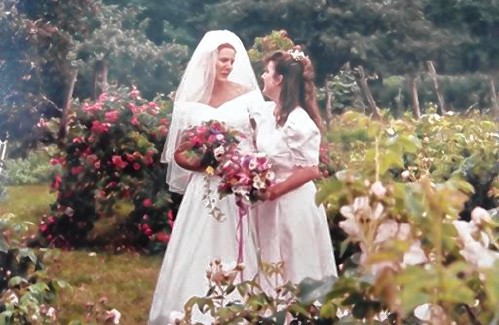Published: 5/24/2020 3:55:53 PM
Over the years, I have been honored to be invited into many gardens. Sometimes gardeners are organizing a garden tour and want publicity. This is always a great opportunity for a columnist. Tour gardeners are always articulate and knowledgeable about their gardens. They are willing to share plant names, advice about care and design thoughts.
It was not long before I created my own annual garden tour. Over the years, it gave me substantial material. It was named the Annual Rose Walk. The first rose I planted was right next to the front door at our previous home in Heath. I could not resist the roses with bawdy names like Cuisse de Nymph and Passionate Nymph’s Thigh. The first is an old rose and some catalogs list it as Maiden’s Blush. Soon, I started to plant roses along a path that led across the lawn to our so-called orchard.
The year that I planted my sixth rose on the path, I invited friends for a tea party and a walk to the roses. One enthusiastic guest said we had to do this every year. And so the Annual Rose Walk became a ritual event, and more and more roses were added. The roses always supplied ideas for columns.
One year, our garden with its Rose Walk was on a Heath Garden Tour. That tour was scheduled for Saturday and Sunday with a buffet lunch served in a neighbor’s Party Barn. Garden touring builds up an appetite and almost all of the Moroccan Chicken Salad and other goodies were eaten on Saturday. That evening, the buffet staff had to drive to Greenfield to buy more chickens, then cook them to have a full buffet on Sunday. The lesson learned: only serve packed lunches.
My Rose Walk did gain some local fame. One day, I got a call from Rachel Burrington Sumner, a Heath grande dame. She was not in her first youth and invited me to her house to dig up her rose if I was interested. Of course I was. We had time to chat and she explained that the rose she was offering was very hardy. Indeed, when her husband covered it with a mountain of soil when he was excavating for a new garage, Rachel thought it was gone forever. Not so. It grew right up through that soil, and Rachel was leaving it to me to tend on the Rose Walk.
Our life on a hill in Heath provided lots of material for columns. One summer, on the 5th of July after a sultry 4th, we were awakened by a terrific thunderstorm at 2 a.m. in the morning. The house shook with the thunder. I looked out the window and said I didn’t see anything. My husband, Henry, sniffed and said he smelled ozone. I said I smelled smoke. Lightning had struck the old barn across the driveway from our house.
He dashed off to see if our neighbor’s phone worked (ours didn’t) and called the fire department. I wandered around the house in my nightgown and wondered what to serve the firemen when they were done. When the first fire trucks arrived, our house was the first consideration as it was already beginning to smoke. The barn collapsed burned and smoldered. One young man passed me on his way to check the pump that was getting water from our Frog Pond. He stopped and asked if we had any cows. I said no, and he nodded at our good fortune. I did get dressed, but as dawn arrived a couple of the firemen’s wives showed up with coffee and cake.
There were other happier topics for columns about family events.
Our youngest daughter was married in the garden in front of the Sunken Garden, a space created by the destruction of the barn. It rained on and off all week before the wedding and the sky was black early on the morning of the wedding day. The guests had barely arranged themselves in the wedding tent when the sky opened and dropped torrents. Everyone laughed. Then, just before the bride and groom were to say their vows, the rain stopped, a brilliant sun appeared and gentle mist came and went as the garden began to dry.
It was a perfect wedding day.
The final chapter in my 40th anniversary celebration will appear next week. Until then, I want to tell you about a tutorial the Franklin County Solid Waste Management District is offering online at Facebook. I’ve gotten many columns out of the lasagna garden techniques I used when we moved to Greenfield in 2015.
Program Director Amy Donovan wrote, “Lasagna Gardening is about utilizing “waste” materials to create and maintain garden areas without tilling the soil. What’s wrong with tilling? Rototilling uses fossil fuels, harms soil microorganisms and earthworms, destroys fungal activity, and can contribute to erosion and poor water absorption. Lasagna gardens contribute to healthy soil, suppress weeds, and absorb water. These layered gardens can be used for new or existing flower gardens, vegetable gardens, or as an alternative to raised beds. Tap/click on the right-hand arrow of each photo to see all the pictures. There is a written explanation of each step.” The link is bit.ly/2ZtWynS.
And, don’t forget today’s Greenfield Garden Club Extravaganza plant sale at the John Zon Community Center from 8:30 a.m. to 12:30 p.m. Wear your masks and maintain social distancing.
P.S., Last week, I said that John Zon was our neighbor in Heath. Of course, he was our neighbor when we lived in Greenfield many years ago.
Pat Leuchtman has been writing and gardening since 1980. Readers can leave comments at her website: commonweeder.com.


